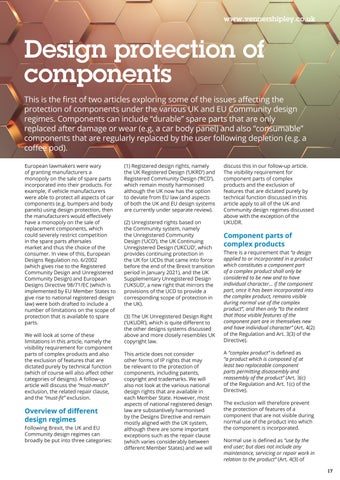www.vennershipley.co.uk
Design protection of components This is the first of two articles exploring some of the issues affecting the protection of components under the various UK and EU Community design regimes. Components can include “durable” spare parts that are only replaced after damage or wear (e.g. a car body panel) and also “consumable” components that are regularly replaced by the user following depletion (e.g. a coffee pod). European lawmakers were wary of granting manufacturers a monopoly on the sale of spare parts incorporated into their products. For example, if vehicle manufacturers were able to protect all aspects of car components (e.g. bumpers and body panels) using design protection, then the manufacturers would effectively have a monopoly on the sale of replacement components, which could severely restrict competition in the spare parts aftersales market and thus the choice of the consumer. In view of this, European Designs Regulation no. 6/2002 (which gives rise to the Registered Community Design and Unregistered Community Design) and European Designs Directive 98/71/EC (which is implemented by EU Member States to give rise to national registered design law) were both drafted to include a number of limitations on the scope of protection that is available to spare parts. We will look at some of these limitations in this article, namely the visibility requirement for component parts of complex products and also the exclusion of features that are dictated purely by technical function (which of course will also affect other categories of designs). A follow-up article will discuss the “must-match” exclusion, the related repair clause, and the “must-fit” exclusion.
Overview of different design regimes Following Brexit, the UK and EU Community design regimes can broadly be put into three categories:
(1) Registered design rights, namely the UK Registered Design (‘UKRD’) and Registered Community Design (‘RCD’), which remain mostly harmonised although the UK now has the option to deviate from EU law (and aspects of both the UK and EU design systems are currently under separate review). (2) Unregistered rights based on the Community system, namely the Unregistered Community Design (‘UCD’), the UK Continuing Unregistered Design (‘UKCUD’, which provides continuing protection in the UK for UCDs that came into force before the end of the Brexit transition period in January 2021), and the UK Supplementary Unregistered Design (‘UKSUD’, a new right that mirrors the provisions of the UCD to provide a corresponding scope of protection in the UK). (3) The UK Unregistered Design Right (‘UKUDR’), which is quite different to the other designs systems discussed above and more closely resembles UK copyright law. This article does not consider other forms of IP rights that may be relevant to the protection of components, including patents, copyright and trademarks. We will also not look at the various national design rights that are available in each Member State. However, most aspects of national registered design law are substantively harmonised by the Designs Directive and remain mostly aligned with the UK system, although there are some important exceptions such as the repair clause (which varies considerably between different Member States) and we will
discuss this in our follow-up article. The visibility requirement for component parts of complex products and the exclusion of features that are dictated purely by technical function discussed in this article apply to all of the UK and Community design regimes discussed above with the exception of the UKUDR.
Component parts of complex products There is a requirement that “a design applied to or incorporated in a product which constitutes a component part of a complex product shall only be considered to be new and to have individual character… if the component part, once it has been incorporated into the complex product, remains visible during normal use of the complex product”, and then only “to the extent that those visible features of the component part are in themselves new and have individual character” (Art. 4(2) of the Regulation and Art. 3(3) of the Directive). A “complex product” is defined as “a product which is composed of at least two replaceable component parts permitting disassembly and reassembly of the product” (Art. 3(c) of the Regulation and Art. 1(c) of the Directive). The exclusion will therefore prevent the protection of features of a component that are not visible during normal use of the product into which the component is incorporated. Normal use is defined as “use by the end user; but does not include any maintenance, servicing or repair work in relation to the product” (Art. 4(3) of 17












